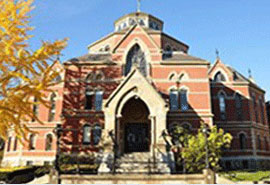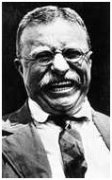
The Kansas City Star
USINFO | 2013-07-12 13:37
The Kansas City Star is a McClatchy newspaper based in Kansas City, Missouri, in the United States. Published since 1880, the paper is the recipient of eight Pulitzer Prizes. The Star is most notable for its influence on the career of President Harry Truman and as the newspaper where a young Ernest Hemingway honed his writing style[1] and for being central to government-mandated divestiture of radio and television outlets by newspaper concerns in the late 1950s.
History
Nelson family ownership (1880–1926)

The paper, originally called The Kansas City Evening Star, was founded September 18, 1880 by William Rockhill Nelson and Samuel E. Morss.[2] The two moved to Missouri after selling the newspaper that became the Fort Wayne News Sentinel (and earlier owned by Nelson's father) in Nelson's Indiana hometown, where Nelson was campaign manager in the unsuccessful Presidential run of Samuel Tilden.
Morss quit the newspaper business within a year and a half because of ill health. At the time there were three daily competitors – the Evening Mail, The Kansas City Times and the Kansas City Journal.
Competitor Times editor Eugene Field wrote this about the new newspaper:
Twinkle, twinkle, little Star
Bright and gossipy you are;
We can daily hear you speak
For a paltry dime a week.[3]
Nelson's business strategy called for cheap advance subscriptions and an intention to be “absolutely independent in politics, aiming to deal by all men and all parties with impartiality and fearlessness.” .[4]
He purchased the Kansas City Evening Mail (and its Associated Press evening franchise) in 1882. The paper name was changed to The Kansas City Star in 1885. Nelson started the Weekly Kansas City Star in 1890 and the Sunday Kansas City Star in 1894.[4] In 1901 Nelson also bought the morning paper The Kansas City Times (and its morning Associated Press franchise). Nelson announced the arrival of the "24 Hour Star."
President Harry S. Truman worked two weeks in August 1902 in the mailroom, making $7.00 the first week and $5.40 the second. In 1950 Truman half joked in an unmailed letter to Star editor Roy Roberts, "If the Star is at all mentioned in history, it will be because the President of the U.S. worked there for a few weeks in 1901."
The paper was first printed on the second story of a 3-story building at 407–409 Delaware. In 1881 it moved 14 W. 5th Street. In 1882 it moved to 115 W. 6th. In 1889 it moved to 804–806 Wyandotte. In 1911 it moved into its Jarvis Hunt-designed building at 18th and Grand.[5]
Nelson died in 1915. Nelson provided in his will that his newspaper was to support his wife and daughter and then be sold.
Ernest Hemingway was a reporter for the Star from October 1917 to April 1918. Hemingway credited Star editor C.G. "Pete" Wellington with changing a wordy high-schooler's writing style into clear, provocative English. Throughout his lifetime he referred to this admonition from The Star Copy Style, the Star's style guide:
"Use short sentences. Use short first paragraphs. Use vigorous English. Be positive, not negative."
Nelson's wife died in 1921; his daughter Laura Kirkwood died in a Baltimore hotel room in 1926 at the age of 43.
Employee ownership (1926–1977)
Laura's husband Irwin Kirkwood, who was editor of the paper, led the employee purchase. Kirkwood in turn died of a heart attack in 1927 in Saratoga Springs, New York, where he had gone to sell thoroughbred horses. Stock in the company was then distributed among other employees.
Virtually all proceeds from the sale and remains of Nelson's $6 million personal fortune were donated to create the Nelson-Atkins Museum of Art on the site of Nelson's home, Oak Hall. Both papers were purchased by the employees in 1926 following the death of Nelson's daughter.
The Star enjoyed a pivotal role in American politics beginning in the late 1920s when Iowa-native Herbert Hoover was nominated at the 1928 Republican convention in Kansas City, and continuing through 1960 at the conclusion of the presidency of Kansas favorite Dwight D. Eisenhower.
Editor Roy A. Roberts (1887–1967) was to make the newspaper a major force in Kansas politics. Roberts joined the paper in 1909 and was picked by Nelson for the Washington bureau in 1915. Roberts became managing editor in 1928. He was instrumental in pushing Kansas Governor Alf Landon for the Republican nomination in 1936; Landon was defeated in the general election by Franklin D. Roosevelt.[6]
In 1942 the Journal, the last daily competitor, ceased publication. The Journal had offered unwavering support of Tom Pendergast's political machine; once Pendergast had fallen from power, the paper suffered.[7]
In 1945 the paper bought the Flambeau Paper Mill in Park Falls, Wisconsin to provide newsprint. The mill was to be cited for pollution problems and have labor problems, and the Star was to eventually divest itself of the mill in 1971.[8]
Roberts was elevated to president of the Star in 1947. The Star was not particularly kind to hometown DemocratHarry Truman, who had been backed by famed big city Democratic Machine boss Tom Pendergast. In 1953, the Truman administration in its closing days filed antitrust charges against the Star over its ownership of WDAF-TV. The Star launched radio station WDAF May 16, 1922, and television outlet WDAF-TV on October 19, 1949. The Star lost its case and had to sign a consent decree in 1957 that led to the sale of the broadcast stations.
With the influence of the Star in Truman's hometown, the newspaper and Roberts were the subject of an April 12, 1948 cover issue of Time Magazine.
In 1954, Topeka correspondent Alvin McCoy won a Pulitzer Prize for a series of articles questioning the business dealings of the Republican national chairman. Roberts reported the Pulitzer Prize in a four paragraph item.
Roberts semi-retired in 1963, officially retired in 1965 and died in 1967.[9]
Corporate Ownership (1977 – present)

Capital Cities/Disney (1977–1997)
Local ownership of the Times and Star ended in 1977 with their purchase by Capital Cities.[10] In 1990 the Star became a morning newspaper taking the place of what was then the larger Kansas City Times which ceased publication. The Walt Disney Company acquired Capital Cities/ABC in January 1996. Disney sold the paper to Knight Ridder in May 1997 as Disney moved to concentrate on broadcast rather than newspaper investments. Under Capital Cities ownership the newspaper won three Pulitzer Prizes.
Knight Ridder/McClatchy (1997 – present)
Knight Ridder's legacy is a massive $199 million, two-block long, glass-enclosed printing and distribution plant on the northeast side of the Star's landmark red brick headquarters at 1729 Grand Avenue. The plant began printing in June 2006. It took nearly four years to build, and is considered a major part of the effort to revitalize downtown Kansas City. The plant contains four 60 foot high presses. On June 4, 2006, the first edition of the Star came out from the new presses with a major redesign in the sections and the logo. The new paper design involved shrinking its broadsheet width from 15 to 12 inches and shrinking the length from 223⁄4 to 211⁄2 inches. Other broadsheet newspapers across the country, including the Wall Street Journal, are moving to the smaller standard size.
The McClatchy Company bought Knight Ridder in June 2006.
Pulitzer Prizes

The newspaper has won eight Pulitzer Prizes:
- 1931 Pulitzer Prize – A.B. MacDonald for articles about a murder in Amarillo, Texas
- 1933 Pulitzer Prize – Editorial Writing
- 1944 Pulitzer Prize – Henry Haskell for Editorial Writing
- 1952 Pulitzer Prize – Coverage of the Great Flood of 1951
- 1954 Pulitzer Prize – Alvin Scott McCoy's local reporting coverage that led to the resignation of C. Wesley Roberts as Republican National Chairman
- 1982 Pulitzer Prize – Local news reporting of the Hyatt Regency walkway collapse (along with The Kansas City Times)
- 1982 – Rick Atkinson (of The Kansas City Times) for national reporting for a series on the West Point Class of 1968
- 1992 Pulitzer Prize – National reporting by Jeff Taylor and Mike McGraw's critical examination of the U.S. Department of Agriculture
- Joe Posnanski
- Jason Whitlock
- Joe McGuff
- Lee Shippey
- William E. Vaughan
- William Allen White
Share this page




















